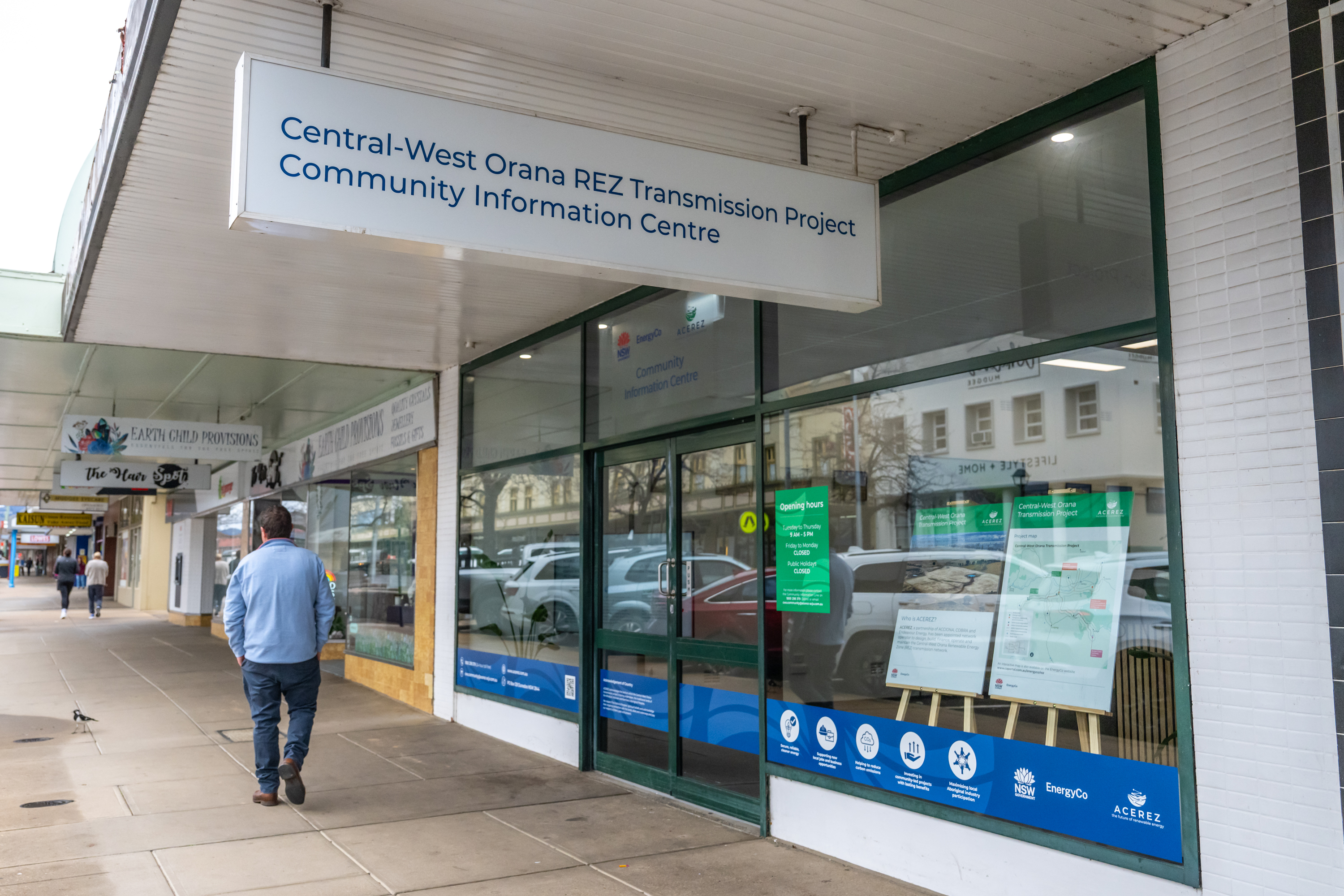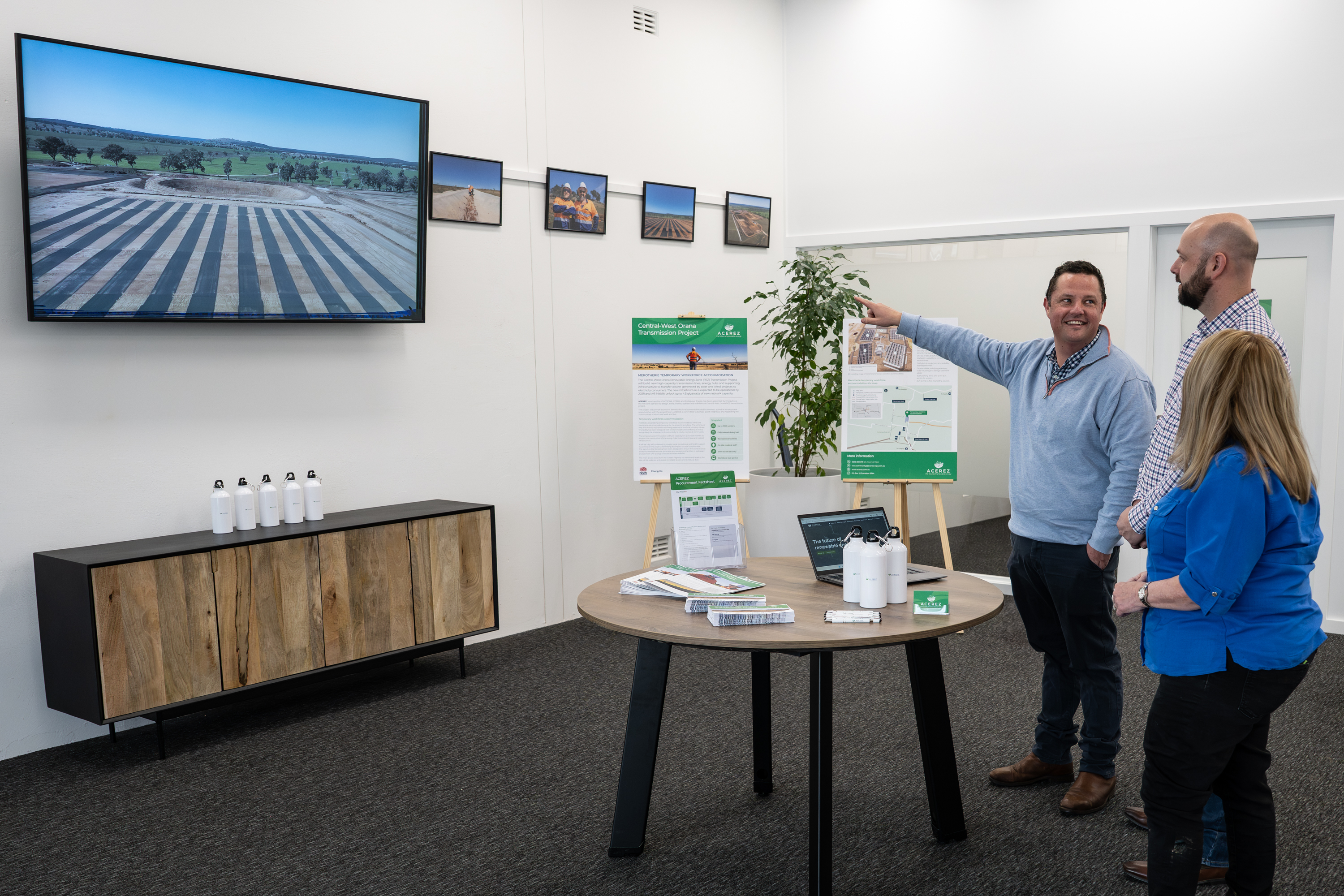Engagement with ACEREZ
For updates or enquiries about the construction of the Central-West Orana REZ Transmission Project you can now engage directly with the network operator, ACEREZ.
More information, including upcoming events and engagements, can be found on their website.
Community reference group (2024 - 2026)
EnergyCo has a Community Reference Group (CRG) for the Central-West Orana REZ which aims to provide an open forum for discussion between EnergyCo, the community and key stakeholders about the REZ transmission project and broader REZ issues. The CRG was established in August 2022.
Recruitment for the 2024-2026 CRG took place in June 2024, following an Expressions of Interest process between 28 May and 18 June 2024. The list of CRG (2024-2026) member are below.
CRG members and documentation
| Name | Organisation | Contact |
|---|---|---|
Kylie Manson | Warrabinga Wiradjuri #7 Native Title Claimants | |
Neville Mattick | Community member | |
| Mark Squires | RE-Alliance | |
Mayor Josh Black | Dubbo Regional Council | |
Councillor Kate Dicker | Mid-Western Regional Council | |
Councillor Kathy Rindfleish | Warrumbungle Shire Council | |
David Thorne | NSW Farmers Mudgee branch | |
Beverley Smiles | Central West Environment Council | |
Rosemary Hadaway | Mudgee District Environment Group & Watershed Landcare | |
David Walker | Burrendong Botanic Garden & Arboretum | |
Tim Booth | Mudgee Region Tourism | |
Jillian Kirwan Lee | Foundation for Regional Rural Renewal | |
Aleshia Lonsdale | Mudgee Local Aboriginal Land Council | |
Colin Kilby | Community representative | |
Jock Rice-Ward | Community representative |
Central-West Orana REZ Regional Steering Committee
The Central-West Orana REZ Regional Steering Committee was established in July 2022. The committee was established to identify and then coordinate the delivery of actions across local and state government agencies to mitigate cumulative impacts in the REZ region and provide community benefits.
Core membership including senior representatives from local host Councils, state government agencies relevant to the cumulative impact focus areas, and EnergyCo. The committee provides a forum for all key stakeholders involved in the effective delivery of cumulative impacts mitigation measures to collaborate and coordinate approach.
The Central-West Orana REZ Regional Steering Committee meets quarterly and will continue to meet to ensure cumulative impacts are effectively managed with support from government at all levels.
Steering Committee Project Group forums
Several Project Group forums have also been established under the Regional Steering Committee to provide a more detailed, technical forum that serves to focus on key critical cumulative impacts. Project Groups have been established for Water, Transport, and Housing & Accommodation.
Similar to the Regional Steering Committee, membership of Project Groups include senior and technical representatives from host Councils, state government agencies relevant to the particular cumulative impact focus area, and EnergyCo.
The Central-West Orana REZ Regional Steering Committee meets quarterly and will continue to meet to ensure cumulative impacts are effectively managed with support from government at all levels.
- EnergyCo
- NSW Premier’s Department
- Infrastructure New South Wales (INSW)
- Department of Primary Industries and Regional Development NSW (DPIRD)
- Department of Planning, Housing and Infrastructure NSW (DPHI)
- Dubbo Regional Council
- Mid-Western Regional Council
- Upper Hunter Shire Council
- Warrumbungle Shire Council
In addition, additional stakeholders beyond the core membership parties may be invited on an as needed basis. These may include (but not limited to):
- NSW Department of Climate Change, Energy, the Environment and Water (DCCEEW)
- Transport for New South Wales (TfNSW)
- Network Operator
- Access Rights Holders
- Meeting No.3 - September 2023.pdf
- Meeting No.4 - October 2023.pdf
- Meeting No.5 - November 2023.pdf
- Meeting No.6 - March 2024.pdf
- Meeting No.7 - April 2024.pdf
- Meeting No.9 - July 2024.pdf
- Meeting No.10 - September 2024.pdf
- Meeting No.11 - December 2024.pdf
- Meeting No.12 - March 2025.pdf
- Meeting No.13 - July 2025
Regional Reference Group
The Regional Reference Group was established in October 2020 and ran until April 2022. The Group was formed as part of the NSW Government’s commitment to engage with the community, landowners and other interested stakeholders about the development of the REZ. It was established in advance of securing any generation projects or defining the transmission route and provided input into the design and development of the REZ as well as ways to maximise and share benefits for regional communities from the project.
The Central-West Orana Renewable Energy Zone Regional Reference Group preceded EnergyCo’s role as infrastructure planner for renewable energy zones.
Local Members of Parliament (State and Federal) | Warrumbungle Shire Council |
Orana Joint Organisation of Councils | Warren Shire Council |
Dubbo Regional Council | Liverpool Plains Shire Council |
| Gilgandra Shire Council | Coonamble Shire Council |
| Mid-Western Regional Council | TransGrid |
| Narromine Shire Council | Essential Energy |
| Upper Hunter Shire Council | Department of Regional NSW |
In addition to the above, stakeholders were also invited to attend as appropriate, including:
- business chambers
- NSW Farmers
- Regional Development Australia
- Landcare
- Agriculture Commissioner
- community and Indigenous representatives.
- 29 October 2020
- 22 February 2021
- 2 June 2021
- 14 October 2021
- 5 April 2022
Learn more about the Central-West Orana REZ
Contact the Central-West Orana REZ team
If you have questions about the Central-West Orana REZ transmission project or would like to provide feedback, please contact us.
For construction or out of hours enquiries, please contact our network operator, ACEREZ on 1800 298 379 or visit acerez.com.au to log an enquiry.
1800 032 101 (9am to 5pm, Monday to Friday)
For construction or out of hours enquiries, please contact our network operator, ACEREZ, on 1800 298 379 or visit acerez.com.au to log an enquiry.
Get in touch with EnergyCo
1800 118 894 (9am to 5pm, Monday to Friday)
Sign up for our Powering NSW e-newsletter.

